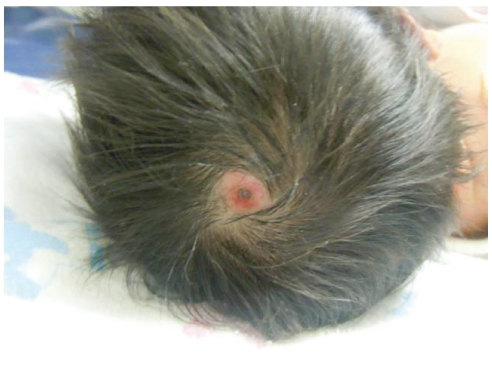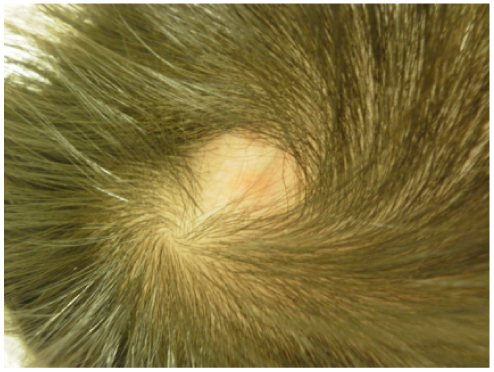Korean J Obstet Gynecol.
2011 Sep;54(9):536-539. 10.5468/KJOG.2011.54.9.536.
A case of aplasia cutis congenita in mother infected with human immunodeficiency virus
- Affiliations
-
- 1Department of Obstetrics and Gynecology, Seoul National University College of Medicine, Seoul, Korea. jsparkmd@snu.ac.kr
- KMID: 2274079
- DOI: http://doi.org/10.5468/KJOG.2011.54.9.536
Abstract
- Aplasia cutis congenita is a rare congenital disorder characterized by single or multiple skin defects at time of birth. After having diagnosed Human immunodeficiency virus infection, the mother took antiretroviral agents during pregnancy and all other antenatal test results were within normal range. Right after birth, a skin defect on the newborn's vertex scalp was detected which was diagnosed as Aplasia cutis congenita. We report a case with a literature review.
MeSH Terms
Figure
Reference
-
1. Frieden IJ. Aplasia cutis congenita: a clinical review and proposal for classification. J Am Acad Dermatol. 1986. 14:646–660.2. Cordon M. Extrait d'une lettre au sujet de 3 enfants de la même mère, nés avec partie des extrémités dénuées de peau. J Med Chir Pharma. 1767. 26:556–557.3. Gerber M, de Veciana M, Towers CV, Devore GR. Aplasia cutis congenita: a rare cause of elevated alpha-fetoprotein levels. Am J Obstet Gynecol. 1995. 172:1040–1041.4. Karg E, Bereg E, Gaspar L, Katona M, Turi S. Aplasia cutis congenita after methimazole exposure in utero. Pediatr Dermatol. 2004. 21:491–494.5. Park G, Kim HJ, Jang HC, Chung H. A case of aplasia cutis congenita after methimazole exposure during pregnancy. Korean J Dermatol. 2006. 44:642–644.6. Sybert VP. Aplasia cutis congenita: a report of 12 new families and review of the literature. Pediatr Dermatol. 1985. 3:1–14.7. Demmel U. Clinical aspects of congenital skin defects. I. Congenital skin defects on the head of the newborn. Eur J Pediatr. 1975. 121:21–50.8. Lemke RP, Machin G, Muttitt S, Bamforth F, Rao S, Welch R. A case of aplasia cutis congenita in dizygotic twins. J Perinatol. 1993. 13:22–27.9. Levin DL, Nolan KS, Esterly NB. Congenital absence of skin. J Am Acad Dermatol. 1980. 2:203–206.10. Stephan MJ, Smith DW, Ponzi JW, Alden ER. Origin of scalp vertex aplasia cutis. J Pediatr. 1982. 101:850–853.11. Evers ME, Steijlen PM, Hamel BC. Aplasia cutis congenita and associated disorders: an update. Clin Genet. 1995. 47:295–301.12. Ingall NW. Congenital defects of scalp: Studies in the pathology development. Am J Obstet Gynecol. 1933. 25:861–869.13. Deeken JH, Caplan RM. Aplasia cutis congenita. Arch Dermatol. 1970. 102:386–389.14. Hubert A, Bonneau D, Couet D, Berthier M, Oriot D, Larrègue M. Aplasia cutis congenita of the scalp in an infant exposed to valproic acid in utero. Acta Paediatr. 1994. 83:789–790.
- Full Text Links
- Actions
-
Cited
- CITED
-
- Close
- Share
- Similar articles
-
- Two Cases of Aplasia Cutis Congenita
- A Case of Aplasia Cutis Congenita after Methimazole Exposure during Pregnancy
- A Case of Aplasia Cutis Congenita Group 4
- Aplasia Cutis Congenita in a Baby born to Hyperthyroid Mother Treated with Methimazole During Pregnancy: A Case Report
- A Cases of Aplasia cutis Congenita



